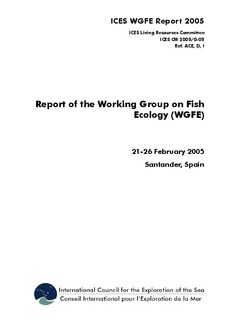| dc.description.abstract | This report details the work undertaken during the third meeting of the ICES Working Group on Fish Ecology (WGFE). The work areas undertaken addressed the following issues: Eco-logical Quality Objectives (EcoQOs) for fish communities (Section 2), fish habitat (Section 3), summarising important fish and fisheries data sets for the North sea and of potential interest to the REGNS project (Section 4), estimates of maximum gear-specific effort levels that North sea elasmobranchs that can be exerted without exceeding the sustainable mortality rates (sec-tion 5), the relative catchability of fishes in different survey gears (Section 6), abundance-range size relationships (Section 7), examination of the decline criteria used by conservation agencies (Section 8), further studies on the prey composition, food rations and gastric evacua-tion of North Sea fishes (Section 9), reviewing the feeding ecology of fish in the North sea and adjacent waters (Section 10), initiating broadscale studies of southern and western surveys (Section 11) and reviewing the updated IBTS manual with reference to the quality assurance for fish identification (Section 12).
Ecological Quality Objectives (EcoQOs) for fish communities are required by OSPAR, and analyses on various size-based metrics have been undertaken by WGFE. In this report (Sec-tion 2) we have summarised the analyses undertaken in previous years, undertaken similar analyses for the Cantabrian Sea, explored the utility of a “predation size spectrum”, and used simulation environments to examine the sensitivity of selected indicators. Future studies will provide a protocol for such studies, explore the categorisation of “large” fish and undertake further evaluation of potential EcoQOs using simulation tools.
Various aspects of fish habitat were described (Section 3), and included a brief summary of the habitat requirements for some deep-water fish species, a description of the Le Danois Bank off the Cantabrian continental shelf, the relationship between physical environmental parameters and fishes in the Barents Sea, and mapping fish diversity in the Canadian Atlantic, with special reference to wolf-fishes. The main ICES data sets that provide useful information on the distribution, relative abun-dance, biology and feeding habits of North sea fishes were summarised for the REGNS pro-ject (Section 4), with a brief overview of the kinds of effort and discards data that are available also provided.
Preliminary studies to explore the gear-specific catchability of elasmobranchs in the North Sean were undertaken (Section 5 and Section 6), with provisional estimates of the maximum gear-specific effort levels that can be exerted without exceeding the sustainable mortality rates for selected species provided (Section 5). This work area will be continued and expanded by the Working Group on Elasmobranch Fishes later this year. Additional studies on the relative catchability of fishes (Section 6) were undertaken for different vessels/gears in the Gulf of St Lawrence (Western IIA otter trawl vs. a fine mesh shrimp trawl URI 81/114), Barents Sea (Norwegian Campelen 1800 trawl vs. Russian research trawls type 2283–02) and Galician waters (Baca trawl vs. beam trawl).
Further analyses of inter-specific and intraspecific abundance-occupancy relationships were undertaken (Section 7), and it was considered that this area of research had potential utility to the conservation and management of fishes, and that further studies should be continued. Case studies examined interspecific relationships in the Barents Sea and North Sea, and intra-specific relationships for thorny skate in the Canadian Atlantic and Norway pout in the North Sea.
The decline criteria used by various conservation fora were examined (Section 8), with results broadly consistent with the outcomes of more rigorous assessment methods (with respect to a matrix of hits, misses and false alarms). In terms of other nature conservation issues for ma-rine fishes, a brief summary of the Canadian Species at Risk Act (SARA) was also provided.
Revised estimates of the prey composition, gastric evacuation and food rations of selected North Sea fishes are in progress (Section 9), though it was recommended that this TOR be addressed in greater detail during 2006. A summary of studies on the feeding ecology of North Sea fishes was also collated (Section 10).
Studies of the fish communities along the continental shelf of the North-eastern Atlantic were summarised, with emphasis on the Cantabrian and Celtic Seas (Section 11). Future studies will further integrate data sets from these regions and WGFE will liaise with IBTS accord-ingly. The revised IBTS manual was also discussed and methods for ensuring high quality for the identification of fishes proposed (Section 12). | en |
